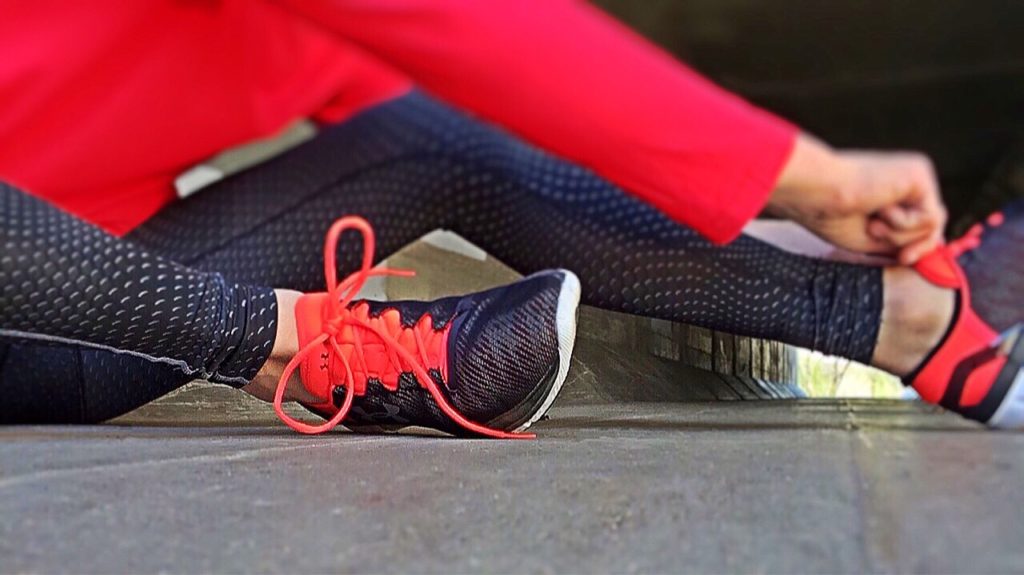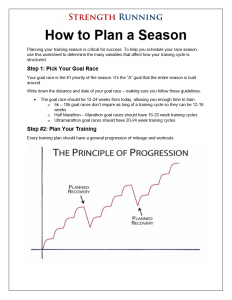Are you ready for a monster discussion on base training, the Maffetone Method, and more training geekery?

I definitely am – and this article is a beast – so grab a cup of coffee and settle in for a wild ride.
Today we’re going to cover several questions and topics:
- What is “base” or “foundational” training?
- What is the Maffetone Method?
- Benefits of the Maffetone Method
- The (significant) drawbacks of the Maffetone Method
- How to design a proper base training phase
I rarely discuss specific training methods (“Run Less, Run Faster” for example) unless I have very strong opinions about them. Like CrossFit Endurance!
But I think there’s a valuable discussion to be had about how runners should build their endurance. And the base phase of training is the perfect place to start this conversation.
So first, what is base training anyway?
What is Base Training?

Let’s see how some famous coaches define base training.
Greg McMillan focuses on leg speed
Greg McMillan, of the “McMillan Running Calculator” fame and author of YOU (Only Faster), defines base training as:
Our base training comes directly from Arthur Lydiard with slight modifications for our athletes. There are two workouts that are performed in the base phase. The first workout is a leg speed workout. Year-round, it is important for distance runners to work on leg speed.
Leg speed workouts are NOT heavy breathing workouts. They are neuromuscular workouts to make sure the brain and muscles remember how to turn the legs over quickly. Since we don’t want to breath heavy (indicating a large build up of lactic acid- a big no-no while in the base phase), these workouts include repeats lasting less than 30 seconds.
A good example might be 10 x 150m striding the first 50m, running quickly the second 50m then at 90% of top speed for the final 50m.
You can see that the focus here is NOT on hard workouts – but even so, there is still a weekly session where you run quite fast.
Brad Hudson points out increases in mileage
And Brad Hudson, coach to many elites and author of Run Faster, explains the base phase (or as he calls it, the “introductory period”) as:
The purpose of the introductory period is to establish an appropriate fitness foundation that will prepare you for the more challenging and focused training of the fundamental and sharpening periods. Priority number one is to gradually but steadily increase your running mileage…
Other priorities of the introductory period include establishing a foundation of neuromuscular fitness with very small doses of maximal-intensity running and beginning the long process of developing efficiency and fatigue-resistance at race pace with small doses of running in the race-pace range
Bob Kennedy emphasizes mixed workouts
Bob Kennedy, the dominant American distance runner in the 1990s and first American to break 13:00 in the 5,000m, agrees. In this article, he says:
There are three basic phases to a training cycle: base, strength, and speed. The problem that most athletes have is that they think [the phases] are mutually exclusive. I think that the phase of training is defined by what you are focusing on during that phase.
But you always do a little of all of those things. There’s never a time of year when you’re just running mileage or you’re just doing speed. You’re always doing all of it, it’s just a matter of to what degree.
Jay Johnson also highlights speed
I also reached out to Jay Johnson, coach to multiple national champions, about what he thinks should be included in a base training phase (or “foundational training” as he calls it):
Foundational training doesn’t need to be so black and white. You can do a progression run that is mostly below [lactate] threshold and it might end with 5 minutes of running that’s just past threshold, yet the amount of lactate produced is minimal and is cleared in just a few minutes of cooling down.
And there is no reason that you can’t be doing strides several days a week.
Takeaways on Base Training
From these definitions, we can agree that base training is preparatory training. It helps build your foundation so that you’re fit enough to tackle more race-specific workouts later in your training cycle by focusing on endurance but also a small amount of very fast and race-pace running.
So, what can we learn from the top minds in running about base training? Here are a few key points:
- The focus during an early-season “base” or “foundational” training phase is aerobic development
- Aerobic development is primarily accomplished through high mileage, long runs, and aerobic-focused workouts like threshold runs, progression runs, and fartleks
- Base training doesn’t exclude faster running, however: the focus is simply on slower running
- Strides, small doses of race-pace work, and neuromuscular workouts like hill sprints should be included in the base phase of training
This type of training is very similar to what my college cross country team ran every summer: mostly easy running but regular strides with an increasing focus on hill repetitions and tempo workouts.
That brings us to today’s spotlight on the Maffetone Method.
What is the Maffetone Method?
Created by Phil Maffetone, the Maffetone Method is a style of training that focuses exclusively on aerobic running. Using a heart rate formula of 180 – your age (plus several corrections for injury, fitness level, health, etc.) you come up with an “aerobic maximum heart rate.”
To build your aerobic fitness (i.e., your endurance), your heart rate should never exceed this number. Most runners use the Maffetone Method for their base training phase, dedicating up to six months of running low-intensity paces that never spike their heart rate over this “aerobic maximum.”
The goal is to improve aerobic development and the percentage of calories burned from fat. Maffetone says on his website:
Some people rely on larger amounts of fat, with the result of high physical and mental vigor, improved health, and better all-around performance.
Those less able to burn sufficient fat must rely more on sugar, resulting in less fat burning each day—a problem associated with reduced health, including low energy, increased body fat and weight, less endurance for daily living, and lower physical fitness.
Phil Maffetone claims the benefits to using his method include reduced inflammation, lower stress hormones (like cortisol), increased fat burning, and the prevention (or REVERSAL) of injuries.
Wow, is this the fountain of youth?! The claims are bold – so let’s discuss the pros and cons of this method of training.
Maffetone Method Benefits & Drawbacks
I can’t agree more with the basic premise of the Maffetone Method: most runners lack aerobic fitness and the best way to improve endurance is through aerobic training.
The majority of runners – particularly beginners and those who start running later in life – must prioritize easy, aerobic running. It’s the foundation upon which more difficult training is built.
But after that high-level agreement, I completely disagree with the mechanics of this method of training. Mostly because, as Mike Smith from Kansas State would say, Maffetone is training “lungs with legs” – and runners are much more than lungs with legs!
There are several great takeaways from this presentation by Coach Jay Johnson:
Most notably, we can say that:
- Runners are athletes and we must develop more abilities than simply aerobic fitness
- Without well-rounded athleticism, runners will never reach their potential
You can also read more about the many components of athleticism here.
Maffetone claims his method provides “balanced physical activity” but then only focuses on one energy system – the aerobic energy system. And within that system, he focuses on the slower end of aerobic development and ignores higher end aerobic workouts like tempo runs at lactate threshold or fast finish progressions.
Goals of Base Training
Brad Hudson believes every energy system should be stressed during every phase of training. In this article, you can see that to get closer to a goal race performance, you have to focus on two types of training: endurance and muscular.
He also says:
We forget that muscles are so important. You have to have the muscular strength to be great. Yes, the aerobic system too—you have to build your aerobic house sometime. So it is really that balance.
Most people get hurt in the transition from what they consider base. And why is that? Because they are not going after the muscles, and it is very foreign to them.
During a base training phase – no matter your fitness level or goals – you must include muscular training that includes very fast running like strides, short race-pace repetitions, or hill sprints, which will all spike your heart rate (briefly) over this “aerobic maximum.”
Alberto Salazar, coach to the 2012 Olympic 10k 1-2 punch Mo Farah and Galen Rupp, believes training is like soup. If you only have one ingredient in your soup, it won’t taste very good. Training is the same; you need all the ingredients included. The other top coaches mentioned in this article agree that base training is not comprised of only easy running.
What Maffetone Method Overlooks
Finally, there are Phil Maffetone’s claims about injury prevention and general health which are exaggerated and unsupported. He says that:
- By training aerobically, your injury will “go away” (like magic!)
- His training methods limit stress and inflammation (but these can be beneficial)
- Maffetone Method increases physical and mental “vigor” and improves “all around performance”
Let’s get a few things straight:
Injuries won’t go away if you simply slow down. Injuries are much more complex than that. You can learn more about injury prevention here.
Stress and inflammation can be good things! We shouldn’t be constantly limiting our exposure to the effects of training – they prompt adaptation and make us stronger and faster.
Vague assumptions don’t prove your training method. Claims like more “mental vigor” and better “all around performance” are unsupported, unclear, and too general to be taken seriously.
What Do Runners Think About the Maffetone Method?

In researching this article, I came across hundreds of testimonials for Maffetone, successful case studies, and scathing criticisms.
Success stories for the Maffetone Method (MAF) usually go something like this:
I trained at MAF all last year and developed a great base. I only broke out of MAF twice – once for a tune-up half before a full marathon, and then again for the full marathon itself.
Wound up setting big PRs in both – demonstrating how poor my aerobic conditioning had been.
But this doesn’t show the Maffetone Method works – it shows this runner simply needed to focus more on his aerobic conditioning and endurance. And any good coach would help him do that, without sacrificing the development of other energy systems.
And remember: just because something works for you doesn’t mean it’s ideal. Most runners could improve even more if they had smarter training. This idea is covered in more detail in my second CrossFit article.
Going Slow = Boring
But most Maffetone Method criticisms don’t focus on training theory or science. They focus on the fact that training this way is incredibly boring! It’s excruciatingly slow.
Here’s a fantastic comment that summarizes a few key points about the Maffetone Method:
I tried the concept for a winter of cycling training and totally sucked it up for the rest of spring.
I honestly feel the concept has little practical scientific backing whatsoever and in a general sense is a waste of precious training time.
Focusing on incorporating a smattering of different training paces ensures that you can fine tune your training in a rather short amount of time to hit a variety of race distances. It also allows one to move into varying aspects of speed work without any significant jolts to the mind/body.
Sure, you can get faster by running slower in the beginning provided your overall stimulus is greater than before, but you can get even faster by running faster! There’s absolutely no reason to completely eschew faster running or running over a certain speed or heart rate. Limiting yourself to an arbitrary ceiling (and using a one-size-fits-all numerical formula is just that) is not the most efficient or effective way to direct your training.
Do you really feel you’re going to maximize your improvement running your 20 mpw at the “excruciatingly slow 10 minute/mile”? I don’t think you will.
Plus, in my opinion, it is a friggin’ SUPER boring way to train!
I can’t agree with this more!
Claims of the Maffetone Method
One article that I won’t call out specifically encouraged runners to spend six months with the Maffetone Method. It told runners they’d likely experience:
- changes in body composition
- more energy
- lack of injuries and illness
- higher sex drive
- faster race times (with no stress or injury)
Unfortunately, you can’t get faster unless you stress your body in a new way. And with only excruciatingly slow mileage, you have to do a LOT of it to see measurable increases in performance.
Just think: if all of your running is easy, where is the stress to prompt you to get faster and stronger?
How to Plan Your Base Training
Rather than focus exclusively on one type of training (aerobic) at the expense of race-specific preparation, there’s a better way to plan base training.
Instead, you’ll want to build a foundation that includes fitness in three major areas: aerobic capacity, strength, and neuromuscular coordination (or leg speed).
Aerobic capacity is built through easy mileage, long runs, and workouts like tempos, progressions, and fartleks.
Strength is also built with high mileage and long runs, but also includes strength routines and core workouts.
Neuromuscular coordination is built through strides, hill sprints, and small amounts of race-pace running.
Just like the foundation of a house can’t be built without concrete, plumbing, and reinforcements, you can’t build a running foundation without all of these ingredients. If you do, it’s not as strong as it could be.
For base training workout ideas, see one of our latest videos:
Even marathoners, who will never run “fast” even during their goal race, need all three components included in their base training.
By working on each aspect of your fitness, none gets “left behind” and you’re more prepared for harder runs later in your training cycle.
My suggestion? Skip the Maffetone Method altogether and take a more modern approach to base training: include strength workouts, strides or hill sprints, and relatively easy fartlek workouts.
You’ll get in better shape – and ultimately race faster.
Get the Season Planner Worksheet
I’ve created a free worksheet to help you plan your season.
It includes the key elements of what to include in your season, plus:
- Example tune-up race scheduling
- The best tune-up race distances for 5k – marathon races
- The 3 ingredients to a successful season
I want to make your next race a HUGE personal best.
It all starts with a good plan, so make sure you sign up in the blue box below to get your free Season Planner Worksheet.